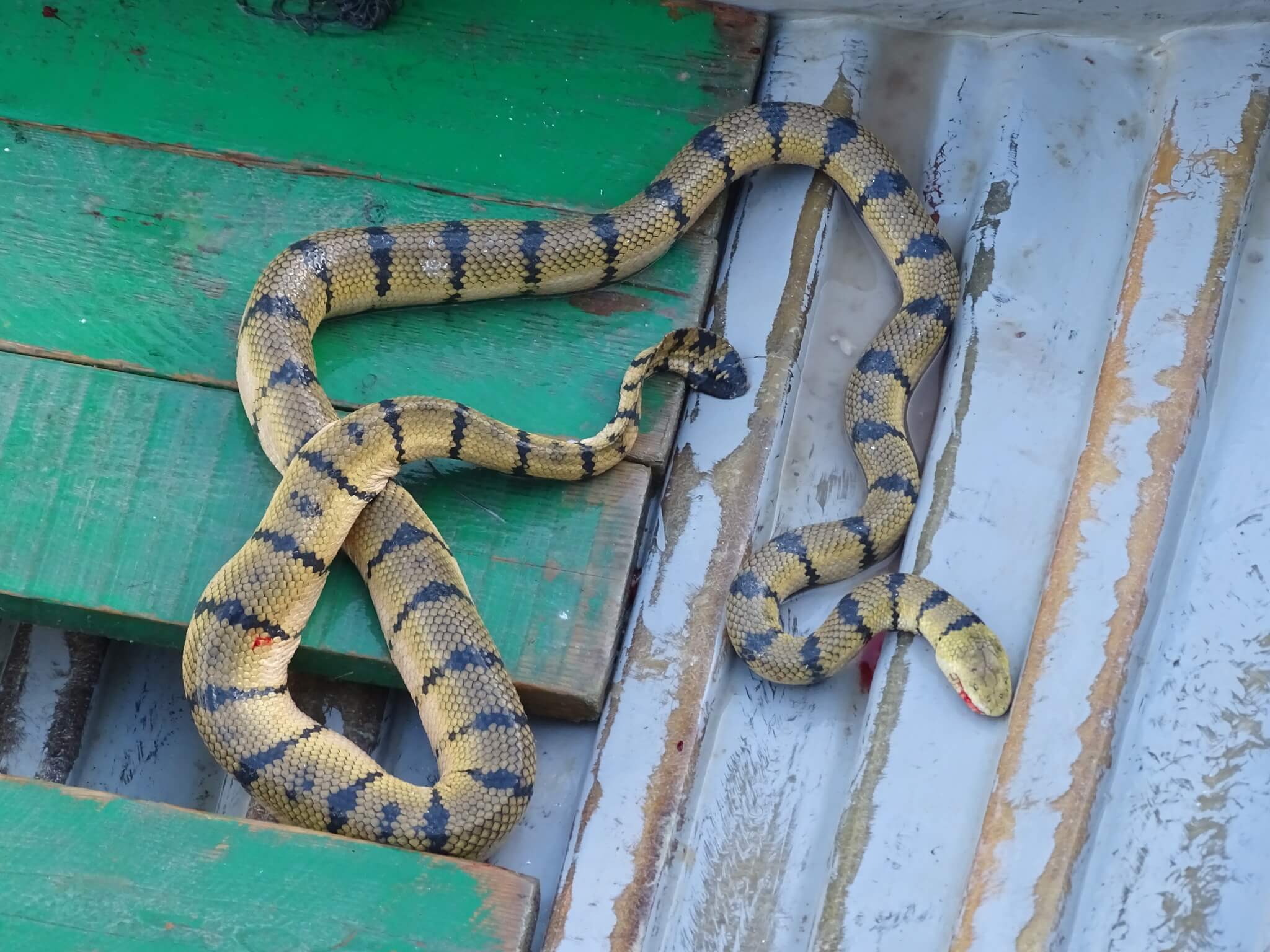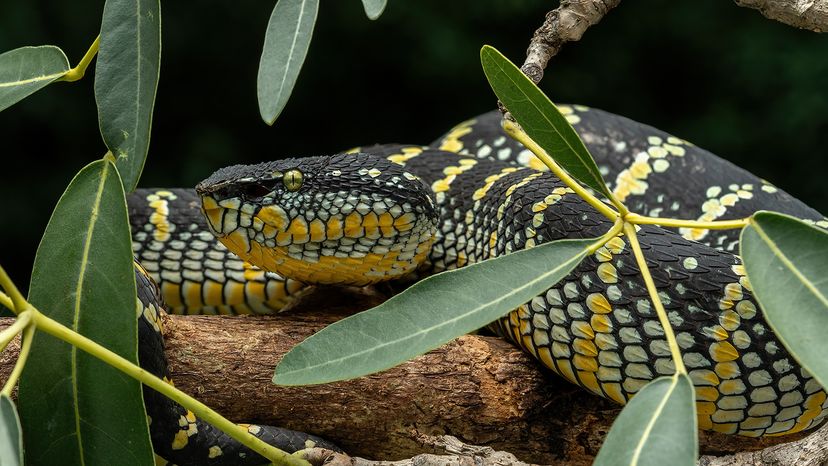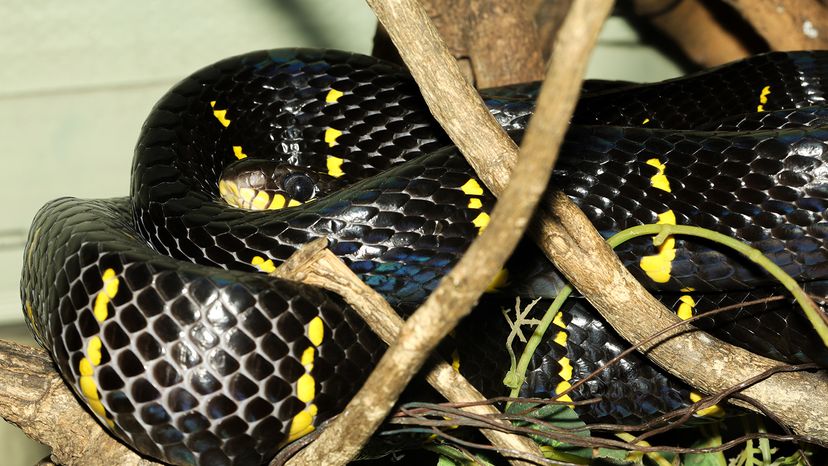The black and yellow snake is vibrant and eye-catching, and its not just for show. In the animal kingdom, bright colors often serve as warnings to potential predators.
But not all black and yellow snakes are venomous; some just like to look the part. That said, youll also want to know which yellow and black snakes with red bands to avoid (looking at you, coral snakes).
Pro tip: You can often identify venomous snakes by their noggins. A triangular-shaped head with a distinct neck (like a spade) typically signifies a venomous snake.
Yellow snakes are some of the most visually striking reptiles out there. Their vibrant yellow coloration makes them stand out against greens and browns of their native habitats. While the color yellow is often associated with danger and toxicity in the animal kingdom not all yellow snakes are venomous. This article will provide an in-depth look at different yellow snake species, their habitats behaviors, care as pets, and more.
Overview of Yellow Snakes
Yellow is an uncommon color in the snake world, so the species that do display it really stand out. Yellow tones can range from a light pastel yellow to a bright canary or goldenrod. The color is most often seen in vipers, pythons, boas, racers, rat snakes, kingsnakes, and more
Some of the most popular pet snakes like ball pythons and corn snakes have been selectively bred to enhance their yellow morphs But many wild species also naturally occur with stunning yellow hues Species span all sizes from large constricting snakes over 20 feet long to tiny shovelsnosed snakes under 1 foot long.
While some are highly venomous like eyelash vipers and coral snakes, most yellow snakes pose no danger to humans. Docile species include the western hognose, common kingsnake, and others.
Habitats and Geographic Ranges
Yellow snakes occupy diverse habitats across the globe. Species thrive in the lush rainforests of South America, woodlands of North America, dense jungles of Southeast Asia, grassy African savannas, and more.
-
Tropical Forests: Eyelash vipers, green pythons, and anacondas inhabit tropical forests and jungles. The canopy and dense vegetation provide ample hiding spots.
-
Deserts: Shovelnose snakes and kingsnakes can be found in the arid deserts of the American Southwest. Their yellow blends into the sandy habitat.
-
Wetlands: Water snakes like the banded krait and mangrove snake frequent marshes, swamps, and other wetlands. Some even live in the ocean.
-
Woodlands: Rat snakes, racers, kingsnakes, and pythons all make their homes in various woodland habitats with scattered trees.
-
Grasslands: Hognose snakes and pythons thrive in wide open grassy areas across continents. Short ground cover suits their ambush hunting.
So yellow snake species have adapted to a wide array of environments. But they tend to thrive in warmer tropical climates. A few hardy species can survive in temperate areas during the summer by hibernating underground in winter.
Yellow Snake Species and Characteristics
Now let’s take a closer look at some specific yellow snake species and their unique traits:
-
Albino Ball Python: A captive bred morph lacking pigment, exhibiting vibrant white and yellow patterning. Docile and easy to handle.
-
Eastern Rat Snake: Up to 6 feet long with olive brown and vibrant yellow blotches. Excellent climbers and swimmers.
-
Corn Snake: America’s most popular pet snake, bred into a rainbow of color morphs including bright yellow and red.
-
Mangrove Snake: Aggressive 8 foot ambush predator from Asia. Recognizable bright yellow stripes on jet black body.
-
Green Tree Python: Arboreal snake from Australia/New Guinea born bright yellow then turning green as an adult.
-
Reticulated Python: The world’s longest snake reaching over 30 feet. Some have complex yellow and white geometric patterning.
-
Hognose Snake: A stout 20 inch species that flatten their necks and spread their heads when threatened. Western morphs are pale yellow.
-
Kingsnake: Powerful constrictors up to 7 feet long. Docile and easy to handle, especially the yellow and white albino morphs.
-
Shovelnose Snake: Tiny snakes with pointed shovel-shaped snouts for burrowing in sand. Uniformly yellow or banded in the deserts of Mexico and southwest US.
-
Pit Viper: Multiple yellow and black banded pit viper species possessing heat sensing pits and long venomous fangs. Tend to be slow-moving but can deliver a dangerous bite.
This list highlights just a small sample of the many yellow snake varieties out there. As you can see, they vary enormously in size, habitat, temperament and level of danger to humans.
Keeping Yellow Snakes as Pets
Thanks to the incredible diversity of yellow snakes, there are suitable species for every experience level. Docile, small to medium snakes like corn snakes, kingsnakes, and ball pythons top the list of beginner friendly yellow pets. Their low maintenance needs and reluctance to bite make them ideal “starter snakes.”
Intermediate keepers may want to explore some of the larger constricting pythons and boas that can exceed 10+ feet in captivity. Their demanding space and feeding requirements are manageable for an experienced herper.
Lastly, only advanced hobbyists should consider highly venomous yellow snakes like vipers and kraits. These snakes require specialized caging and handling precautions to prevent envenomation. Strict regulations also restrict ownership in many areas.
When keeping any yellow snake as a pet, be sure to carefully research their specific care needs. Factors like enclosure size and setup, temperature gradients, humidity levels, food items, handling techniques, and more vary significantly between species. Providing a habitat that mimics their natural environment is key to long term health and happiness.
Why Are Some Snakes Yellow?
There are two main reasons snakes evolve yellow coloration:
Camouflage – Yellow allows certain species like the shovelnose snake to blend in with sandy desert surroundings. It provides crucial cryptic coloring that hides them from predators and prey.
Warning Coloration – Vibrant yellow markings on vipers, coral snakes, and other venomous species ward off would-be predators. This aposematic coloration alerts others to their dangerous bite.
Yellow snakes exhibit some of the most vibrant and varied colorations in the reptile world. They’ve adapted to thrive in habitats ranging from lush jungles to barren deserts. A wide spectrum exists between harmless and dangerous yellow snakes. Their diversity provides the perfect snake for every experience level and preference – from tiny docile shovelnose snakes to massive reticulated pythons. Proper research helps ensure yellow snakes remain healthy and fulfilling pets. The stunning yellow morphs will brighten any herper’s collection!

Pit Viper
The pit viper family includes some of the most dangerous snakes in the world, though not all of them sport black and yellow coloration.
Pit vipers have heat-sensing pits between their eyes and nostrils, helping them detect warm-blooded prey even in total darkness. With highly venomous bites, these snakes are serious hunters in the wild.
Cat-eyed Snake
The cat-eyed snake is a nocturnal predator that uses its large, cat-like eyes to hunt prey under the cover of darkness. The juveniles are a more distinct black and yellow, whereas the mature cat-eyed snakes have more muted dark brown coloration.
Found in Central and South America, it it may look fierce, but this snake is only mildly venomous and poses no significant threat to humans. It prefers to prey on small amphibians and other cold-blooded creatures, taking advantage of its keen night vision.
Yellow Eyelash Viper | Untamed
FAQ
What kind of snake is yellow?
The yellow rat snake, or chicken snake, is known to feed on domestic fowl (i.e. chickens) and their eggs. This practice is how they came to receive one of their common names, “chicken snake”. Like pythons and boas, rat snakes are constrictors, which suffocate their prey.
What does it mean when you see a yellow snake?
… is often associated with happiness so seeing a yellow snake could symbolize the end of a sad, gloomy phase and the beginning of a joyful phase in your lifeMay 8, 2023
Are yellow corn snakes poisonous?
While not venomous, corn snakes will bite. Their striking range is quite long, about 1/3 to 1/2 of their body length.
Are yellow pythons poisonous?
-
Pythons are constrictors:They kill their prey by squeezing them to suffocation, not through venom.
-
are known for their distinctive yellow-cream color with peach or orange rings or shapes bordered in white.
-
Pythons can be dangerous:Despite not being venomous, larger pythons can pose a threat due to their size, sharp teeth, and ability to cause severe lacerations with their bites.
-
Potential health risks:While not poisonous, pythons can carry diseases that can be transmitted to humans, such as Salmonella, Chlamydia, Leptospirosis, Aeromoniasis, Campylobacteriosis, and Zygomycosis.
-
Not all yellow snakes are poisonous:It’s important to note that not all snakes that appear yellow or have yellow markings are venomous, but some may be, so caution is always advised when encountering any snake.
What is a yellow rat snake?
The yellow rat snake is a medium-sized constrictor native to the southeast region of America. An adult yellow rat snake can reach up to 6 feet in length. Naturally a docile breed, the yellow rat snake makes a great beginner pet snake.
Which snakes are yellow?
Various species of snakes can be yellow. These include large pythons, agile boas, and arboreal Morelia snakes. Common in the exotic snake pet world, these snakes are also seen in the wild, particularly in rainforests and woodlands. Here are the most common species of snakes that are yellow and what makes them different.
Where are yellow snakes commonly found?
Yellow snakes are commonly found in the wild, particularly in rainforests and woodlands. Various species of snakes can be yellow, including large pythons, agile, boas, or arboreal Morelia snakes. Common in the exotic snake pet world, these snakes are also seen in the wild.
Are yellow snakes venomous?
While some snakes with yellow details are venomous, not all yellow snakes are dangerous. Many yellow snakes are nonvenomous and harmless to humans, such as Australia’s jungle carpet python.
What is a yellow tree snake?
These yellow snakes with brown stripes are medium-sized, with an average size of 55 to 137 cm. These viviparous snakes prefer a variety of habitats, including meadows, marshes, woodlands, and hillsides. They are cold-resistant and can adjust between 68 and 98.6 degrees Fahrenheit. 2. Golden tree snake
What kind of snakes are blue & yellow?
These blue and yellow snakes are found in a variety of habitats ranging from rainforests to woodland. Australian tree snake or common tree snake are the common names of Dendrelaphis punctulatus. These agile snakes are blue in color and their ventral sides are golden yellow to bright green.


